| Listing 1 - 10 of 49 | << page >> |
Sort by
|
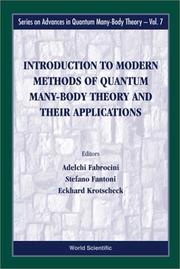
ISBN: 9812777075 9789812777072 9789812380692 9812380698 9812380698 Year: 2002 Volume: 7 Publisher: River Edge, NJ World Scientific
Abstract | Keywords | Export | Availability | Bookmark
 Loading...
Loading...Choose an application
- Reference Manager
- EndNote
- RefWorks (Direct export to RefWorks)
This invaluable book contains pedagogical articles on the dominant nonstochastic methods of microscopic many-body theories - the methods of density functional theory, coupled cluster theory, and correlated basis functions - in their widest sense. Other articles introduce students to applications of these methods in front-line research, such as Bose-Einstein condensates, the nuclear many-body problem, and the dynamics of quantum liquids. These keynote articles are supplemented by experimental reviews on intimately connected topics that are of current relevance. The book addresses the striking
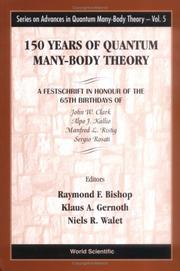
ISBN: 1281951331 9786611951337 9812799761 9789812799760 9789810247300 9810247303 Year: 2001 Publisher: Singapore River Edge, NJ World Scientific
Abstract | Keywords | Export | Availability | Bookmark
 Loading...
Loading...Choose an application
- Reference Manager
- EndNote
- RefWorks (Direct export to RefWorks)
In July 2000 a conference was held to honour the 65th birthdays of four of the leading international figures in the field of quantum many-body theory. The joint research careers of John Clark, Alpo Kallio, Manfred Ristig and Sergio Rosati total some 150 years, and this festschrift celebrated their achievements. These cover a remarkably wide spectrum. The topics in this book reflect that diversity, ranging from formal aspects to real systems, including nuclear and subnuclear systems, quantum fluids and solids, quantum spin systems and strongly correlated electron systems. The book collects more
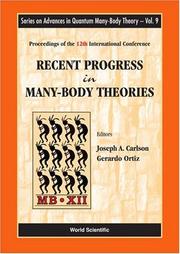
ISBN: 1281924504 9786611924508 9812772898 9789812772893 981256957X 9789812569578 Year: 2006 Volume: v. 9 Publisher: Hackensack, N.J. World Scientific
Abstract | Keywords | Export | Availability | Bookmark
 Loading...
Loading...Choose an application
- Reference Manager
- EndNote
- RefWorks (Direct export to RefWorks)
Quantum many-body theory has greatly expanded its scope and depth over the past few years, treating more deeply long-standing issues like phase transitions and strongly-correlated systems, and simultaneously expanding into new areas such as cold atom physics and quantum information. This collection of contributions highlights recent advances in all these areas by leaders in their respective fields. Also included are some historic perspectives by L P Gor'kov and S T Belyaev, Feenberg Medal Recipients at this conference, and Nobel Laureate P W Anderson gives his unique outlook on the future of
Book
ISBN: 1281924458 9786611924454 9812772782 9789812772787 Year: 2006 Volume: v. 10 Publisher: Hackensack, NJ World Scientific
Abstract | Keywords | Export | Availability | Bookmark
 Loading...
Loading...Choose an application
- Reference Manager
- EndNote
- RefWorks (Direct export to RefWorks)
This conference series is now firmly established as one of the premier series of international meetings in the field of many-body physics. The current volume maintains the tradition of covering the entire spectrum of theoretical tools developed to tackle important and current quantum many-body problems. It aims to foster the exchange of ideas and techniques among physicists working in diverse subfields of physics, such as nuclear and sub-nuclear physics, astrophysics, atomic and molecular physics, quantum chemistry, complex systems, quantum field theory, strongly correlated electronic systems
Book
ISBN: 1283899922 9812792759 9789812792754 Year: 2000 Publisher: Singapore World Scientific
Abstract | Keywords | Export | Availability | Bookmark
 Loading...
Loading...Choose an application
- Reference Manager
- EndNote
- RefWorks (Direct export to RefWorks)
Quantum many-body theory as a discipline in its own right dates largely from the 1950's. It has developed since then to its current position as one of the cornerstones of modern theoretical physics. The field remains vibrant and active, vigorous and exciting. Indeed, its successes and importance were vividly illustrated prior to the conference by the sharing of the 1998 Nobel Prizes in both Physics and Chemistry by three many-body theorists. Two of those Nobel laureates, Walter Kohn and Bob Laughlin, delivered invited lectures at this meeting, the tenth in the series of International Conferenc
Book
ISBN: 1281938181 9786611938185 9812779884 9789812779885 9789812779878 9781281938183 6611938184 Year: 2008 Volume: v. 11 Publisher: Singapore World Scientific
Abstract | Keywords | Export | Availability | Bookmark
 Loading...
Loading...Choose an application
- Reference Manager
- EndNote
- RefWorks (Direct export to RefWorks)
This volume contains the main contributions to the 14th International Conference on Recent Progress in Many-Body Theories (RPMBT14) held at the Technical University of Catalonia, Spain, in July 2007. This conference, which was first held in Trieste in 1979, is devoted to new developments in the field of many-body theories, which are being applied and developed in a rapidly growing number of fields. The emphasis is twofold: progress in the technical aspects of microscopic theories and a review of recent applications of many-body techniques. In addition to the more traditional topics, such as nu
Book
ISBN: 9780521864886 9781139020916 Year: 2015 Publisher: Cambridge Cambridge University Press
Abstract | Keywords | Export | Availability | Bookmark
 Loading...
Loading...Choose an application
- Reference Manager
- EndNote
- RefWorks (Direct export to RefWorks)
Book
ISBN: 1283143518 9786613143518 9812790667 9789812790668 9789812790644 9812790640 9789812790651 9812790659 Year: 2010 Publisher: Hackensack, NJ World Scientific
Abstract | Keywords | Export | Availability | Bookmark
 Loading...
Loading...Choose an application
- Reference Manager
- EndNote
- RefWorks (Direct export to RefWorks)
The two most important developments in nuclear physics were the shell model and the collective model. The former gives the formal framework for a description of nuclei in terms of interacting neutrons and protons. The latter provides a very physical but phenomenological framework for interpreting the observed properties of nuclei. A third approach, based on variational and mean-field methods, brings these two perspectives together in terms of the so-called unified models. Together, these three approaches provide the foundations on which nuclear physics is based. They need to be understood by e
Many-body problem. --- Nuclear collective models. --- Nuclear spectroscopy.
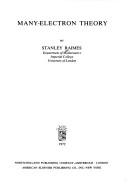
ISBN: 0720402425 0444103538 Year: 1972 Publisher: Amsterdam North-Holland
Abstract | Keywords | Export | Availability | Bookmark
 Loading...
Loading...Choose an application
- Reference Manager
- EndNote
- RefWorks (Direct export to RefWorks)
Quantum mechanics. Quantumfield theory --- Electrons. --- Many-body problem. --- Many-body problem --- Electrons --- Problème des N corps
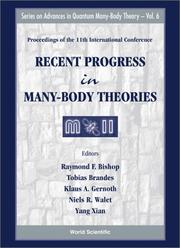
ISBN: 1281929816 9786611929817 9812777849 9789812777843 9810248881 9789810248888 9781281929815 6611929819 Year: 2002 Publisher: Singapore River Edge, NJ World Scientific
Abstract | Keywords | Export | Availability | Bookmark
 Loading...
Loading...Choose an application
- Reference Manager
- EndNote
- RefWorks (Direct export to RefWorks)
Quantum many-body theory as a discipline in its own right dates largely from the 1950's. It has developed since then to its current position as one of the cornerstones of modern theoretical physics. The field remains vibrant and active, vigorous and exciting. Its most powerful techniques are truly universal. They are constantly expanding to find new fields of application, while advances continue to be made in the more traditional areas. To commemorate the impending 80th birthdays of its two co-inventors, Firtz Coester and Hermann Kümmel, one such technique, namely the coupled cluster method, w
Many-body problem --- Quantum theory. --- Quantum dynamics --- Quantum mechanics --- Quantum physics --- Physics --- Mechanics --- Thermodynamics
| Listing 1 - 10 of 49 | << page >> |
Sort by
|

 Search
Search Feedback
Feedback About UniCat
About UniCat  Help
Help News
News